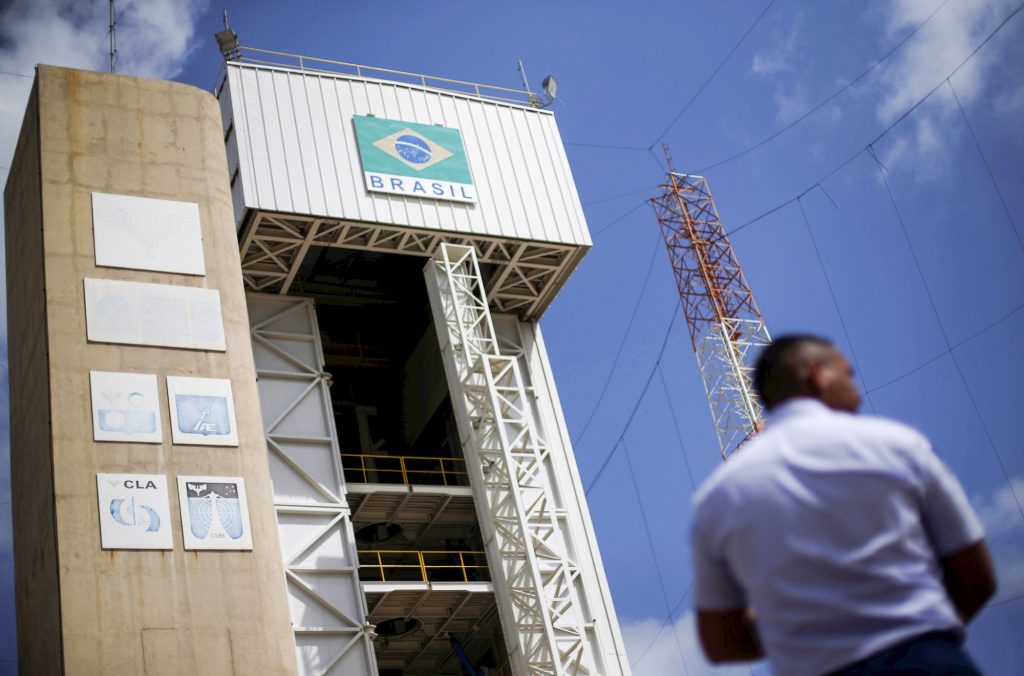
The year 2020 marks the turning of a page for the Western Hemisphere, a region that in 2019 saw uncertainty dominate headlines as new governments came in and out of office, trade tensions grew, and citizens took to the streets to voice their concerns with the status quo.
For years, the opportunities that could come with a stronger bilateral relationship between the United States and Brazil have been underestimated. Significant potential exists to produce sizeable benefits for both societies. That potential must be maximized.
While US and Brazilian governments and businesses have begun to seize the benefits of the synergies the two countries share, hurdles remain that prevent a full and successful commercial reality.
The United States and Brazil would benefit from a closer and stronger trade and foreign-direct-investment-relationship that would amplify growth and prosperity, in both the short and long terms. Deepening the economic relationship would pay dividends in other areas as well, translating into greater opportunities for strategic bilateral cooperation. This paper recognizes that the moment is now and that 2020 is a pivotal year to substantively advance bilateral economic ties.
Building upon the successes and progress made over the years, this paper incorporates the input and expertise of the US and Brazilian private sectors and policymakers to offer a renewed vision and new momentum for strengthening US-Brazil trade and foreign direct investment (FDI), supporting concrete steps toward deepening the commercial relationship, and laying the foundation for a potential free trade agreement (FTA) between the United States and Brazil.
As the global balance of power shifts, as the world faces new hurdles that could slow growth, and as Latin America must contend with more uncertainty amid new external shocks, the two countries strategically and economically have countless reasons to deepen commercial relations. Stronger ties will ultimately provide additional certainty at this critical time.
Jason Marczak
Director, Adrienne Arsht Latin America Center Atlantic Council
Scan the global horizon today and one can’t help but note the trends that are fundamentally reshaping the world order. New global players are taking center stage, as countries reconsider their approaches to collaboration and cooperation. Changes in technology are evolving at unprecedented speeds—changes that have brought forward a fourth industrial revolution that has generated new questions about how best to solve global challenges not confined by borders. These transformative trends are affecting the world, and the marketplace. But, change also brings immense opportunity.
In this environment, the United States and Brazil are uniquely positioned to advance momentum for a more robust bilateral economic relationship. As the United States and Brazil look at delivering on such a goal, the Atlantic Council’s Adrienne Arsht Latin America Center, alongside intellectual partners in both countries, lays out the benefits that a closer economic relationship may offer. The goal: provide new ideas and reinforce momentum for deepening the bilateral relationship at a time of great synergy between the countries’ leadership.

An open, transparent, inclusive, and international rules-based bilateral trading system is key to sustainable growth and prosperity for the United States and Brazil.
Share this quoteThis paper, authored by two US and two Brazilian experts, showcases the scope for the United States and Brazil of deepening trade and FDI ties. In particular, it highlights the institutional hurdles and opportunities for lowering trade barriers and enhancing convergence in the near term, while articulating the benefits of a comprehensive free trade agreement in the long term, as well as what the two countries can do to achieve even stronger investment ties. To highlight the potential benefits of a stronger US-Brazil partnership and increased investment in different sectors of the economy, this paper, from a bilateral and non-partisan perspective, proposes short-term and long-term approaches to seizing on opportunities for greater engagement. It also highlights, through call-out boxes, the authors’ perspectives on key themes and opportunities for particular industries.
Throughout 2020, the United States and Brazil have the chance to focus on key, practical, short-term wins that could pave the way for next steps toward a comprehensive long-term free trade agreement.
In the areas of trade, recommendations include a multi-chapter trade enhancement agreement that could encompass bilateral rules on customs administration and trade facilitation, good regulatory practices, technical barriers to trade, and digital trade, among other areas. Working closely with the private sectors of the two countries, the United States and Brazil should continue to identify specific bottlenecks to reduce trade uncertainty, and work to finalize a mutual recognition agreement between national trusted traders or Authorized Economic Operator (AEO) programs. Key to short-term success will be expanding digital documentation in bilateral trade and expanding upon sharing good regulatory practices, including conducting impact analyses and public consultations, and implementing a whole-of-government approach.
The two countries should work to move beyond the pilot program to establish a full-fledged Global Entry Program for pre-approved Brazilian travelers entering the United States, start negotiations to avoid double taxation, and consider the implementation of a high-level mechanism at the vice presidential level to oversee the bilateral relationship (in coordination with existing dialogues and groups). The United States and Brazil can also increase policy cooperation in third countries and international fora in areas of investment and trade policy coherence.
The United States should continue to support Brazil’s process of accession to the Organisation for Economic Co-operation and Development (OECD), which would energize and consolidate important economic domestic reforms in Brazil.
Beyond 2020, and using momentum of short-term progress, the United States and Brazil should work toward launching and concluding negotiations for a comprehensive free trade agreement (FTA) and bilateral investment treaty (BIT).
An open, transparent, inclusive, and international rules-based bilateral trading system is key to sustainable growth and prosperity for the United States and Brazil. By articulating the spillover effects of stronger ties from a bilateral approach, this paper provides a new perspective on the benefits of closer trade and investment linkages between the two countries. The moment to catapult the joint relationship to the next level is now.
As the two largest economies in the Western Hemisphere, the United States and Brazil have a long and prosperous relationship, one dating back to 1824, when the United States became one of the first countries to recognize Brazil’s independence. 1 Randig, Rodrigo. Argentina: O Primeiro Pais a Reconhecer a Independencia do Brasil. Fundação Alexandre de Gusmão. 2017. Accessed at: http://www.itamaraty. gov.br/images/ficha_pais/artigo-argentina.pdf
More recently, and over the course of decades, Brazil and the United States have taken steps to foster deeper engagement within sectors of strategic mutual importance. These have included the aerospace, energy, tourism, defense and security, healthcare, infrastructure, and automotive industries, among many others.
The partnership is one characterized by a shared vision of growth and prosperity, while each country’s viewpoint regarding the role of the public and private sectors in leading growth has varied. Recent numbers give a glimpse of the mutual benefits behind the bilateral relationship. In 2018, two-way trade in goods and services amounted to more than $100 billion, which is also likely to be the case in 2019.*
As Latin America’s largest democracy and economy, Brazil ranks fourteenth as a US trading partner, and it is the United States’ number-two destination for goods in the region.
For Brazil, the United States is a crucial economic and commercial partner. As of 2019, the United States ranked as Brazil’s second-largest trading partner— having only recently been overtaken by China—when considering goods and services together. The United States is the most important destination for Brazilian exports in services and in manufactured products. In terms of FDI, while flows from China have accelerated in recent years (especially in the energy and infrastructure industries), the United States remains the largest investor of FDI in Brazil—five times greater than China, reflecting the breadth and depth of the longstanding relationship between the United States and Brazil. 2 The United States holds 15 percent of foreign direct investment (FDI) in Brazil, equivalent to $119 billion in 2017 (against a lower $95 billion, with a methodology that includes immediate investment highlighting the use of intermediaries for US corporations). This US position takes the form (over 80 percent) mostly of equity, reinvested profits, or flows, rather than debt or intercompany loans. While China has risen in to hold 2.7 percent to the stock of FDI in 2017 to $21 billion, up nearly threefold from $7.9 billion in 2010, the United States remains more significant. According to the Policy Center for the New South, while the Central Bank of Brazil has indicated that between 2014 and the first semester of 2018, the flows of Chinese investment in Brazil accumulated $20.7 billion, the Secretariat of International Affairs of the Ministry of Planning, Development, and Management (SEAIN-MPDG) estimates an amount of $28.6 billion. Banco Central do Brasil Direct Investment Report 2018.
The United States also benefits from its relationship with Brazil. As Latin America’s largest democracy and economy, Brazil ranks fourteenth as a US trading partner, and it is the United States’ number-two destination for goods in the region. According to the US Trade Representative (USTR), in 2018, the United States had an overall trade surplus of $30.6 billion for goods and services, including an $8.5 billion trade surplus for goods alone. 3 Brazil. Office of the US Trade Representative. Accessed at: https://ustr.gov/sites/default/files/2013%20NTE%20Brazil%20Final.pdf Brazil’s main imports from the United States are aircraft, machinery, petroleum products, electronics, and optical and medical instruments.
One can look at the number of student exchanges between the United States and Brazil as another example of the importance of the bilateral relationship—Brazil is the ninth-leading country sending students to the United States. 4 Brazil is now the ninth-leading country worldwide sending students to the United States. US Embassy and Consulates in Brazil. US Mission Brazil. November 18, 2019. Accessed at: https://br.usembassy.gov/brazil-is-now-the-9th-leading-country-worldwide-sending-students-to-the-united-states/ Between 2017 and 2018, per US Immigration and Customs’ SEVIS (Student and Exchange Visitor Information System) by the Numbers Report, the number of Brazilian students studying in the United States increased by 13.1 percent. 5 SEVIS by the Numbers. US Immigration and Customs Department. US Department of Homeland Security. May 3, 2018. Accessed at: https://studyinthestates.dhs.gov/2018/05/sevis-by-the-numbers-more-south-american-students-in-the-us From 2018 to 2019, that number increased by 9.8 percent, the second-largest percentage increase in international students from any country worldwide in that timespan. 6 ibid
There is no denying that the United States and Brazil are key partners and allies. But the two largest economies in the Americas have yet to remove the barriers necessary to maximize the full potential of actual and possible trade and investment ties.
The positive state of bilateral relations offers a unique opportunity to build momentum to deepen economic ties in this longstanding and enduring partnership. The key reforms being advanced in Brazil to strengthen the economy, and the role of the private sector in it, make this an opportune moment to advance and achieve key short-term outcomes that would position both countries to deepen and expand trade and investment in the longer term.
Over the past year, the administrations of US President Donald Trump and Brazilian President Jair Bolsonaro have made commitments to further bring the two economies closer together in increasing prosperity, enhancing security, and promoting democracy and national sovereignty.
In his first bilateral visit abroad after assuming office, President Bolsonaro met in Washington, DC, with President Trump in March 2019, joined by seven of his twenty-two ministers, including Economy Minister Paulo Guedes, Justice Minister Sérgio Moro, and Foreign Affairs Minister Ernesto Araújo. The visit defined an agenda that prioritized expanding cooperation in trade and FDI, defense and security, and innovation.
As the United States and Brazil look at further delivering on a stronger bilateral agenda, this publication sheds light on the possibilities to advance short-to-long-term commercial opportunities in numerous sectors.
Share this quoteOn more than one occasion, leaders of both countries have expressed their willingness to negotiate a trade agreement—notwithstanding the complicated and ongoing challenges that have held back such negotiations in the past. 7 Trump says he will seek U.S. trade accord with Brazil. Reuters. Accessed at: https://www.reuters.com/article/ us-usa-trade-brazil/trump-says-he-will-seek-u-s-trade-accord-with-brazil-idUSKCN1UP1KA; and Brazil and US strengthen ties, free trade in the pipeline, DW. Accessed at: https://www.dw.com/en/brazil-and-us-strengthen-ties-free-trade-in-the-pipeline/a-50428682 The two presidents have thus far made several specific trade-related commitments. They agreed to build a Prosperity Partnership to increase jobs and reduce barriers to trade and investment, putting emphasis on exploring new initiatives to facilitate trade, investment, and good regulatory practices. They also pressed for the conclusion of a mutual recognition agreement regarding their trusted trader or AEO programs.
To show their mutual intent to tackle some long-standing bilateral trade disputes, President Bolsonaro announced the intention to expand US access to the Brazilian wheat and pork markets, while President Trump indicated the United States would take steps to resume Brazil’s beef exports. Brazil has also implemented the commitment to extend the annual duty-free tariff rate quota (TRQ) of 750,000 metric tons (MT) of wheat imports. 8 Brazil’s Implementation of Tariff Rate Quota for Wheat a Win for American Farmers. Office of the United States Trade Representative. November 14, 2019. Accessed at: https:// ustr.gov/about-us/policy-offices/press-office/press-releases/2019/november/brazil%E2%80%99s-implementation-tariff
As written in the joint statement between the two countries, President Trump offered his support for Brazil’s accession to the OECD—a process that started in 2017 with Brazil formally expressing its interest in joining the organization—and President Bolsonaro announced that Brazil will begin to forgo special and differential treatment in World Trade Organization (WTO) negotiations.
Brazil affirmed it would waive the tourist visa requirement for US citizens to enter the country, which became effective in June 2019, and both presidents agreed they would work to enable Brazil to participate in the US Global Entry Program. 9 Diario Oficial da União. Decreto No 9.731. March 16, 2019. Accessed at: http://www.in.gov.br/materia/-/as-set_publisher/Kujrw0TZC2Mb/content/id/67423098 They also decided to resume the activities of the Brazil-US CEO Forum.
On the defense-and-security front, both countries signed a Technology Safeguards Agreement that enables US spacecraft to be launched from Brazil’s Alcântara Launch Center. The agreement was approved by Brazil’s Congress in November 2019 and launches are expected to begin in 2021. 10 Brazil Senate Approves Technology Safeguard Agreement with U.S.. US News and World Report. November 12, 2019. Accessed at: https://www.usnews.com/ news/technology/articles/2019-11-12/brazil-senate-approves-technology-safeguard-agreement-with-us This agreement is part of a broader effort to continue expanding bilateral cooperation beyond trade. The United States also designated Brazil as a “major non-NATO ally,” facilitating Brazil’s ability to purchase US weapons and defense equipment. 11 Trump officially designates Brazil a non-NATO ally. The Hill. July 31, 2019. Accessed at: https://thehill.com/homenews/administration/455642-trump-officially-designates-brazil-non-nato-ally
The Brazil-US CEO Forum, which met in Washington, DC in November 2019 after a four-year lapse, also laid the groundwork for deeper collaboration. The chief executive officers’ (CEOs’) joint recommendations included “proposals to increase bilateral trade, infrastructure cooperation, collaboration in the technology sector, and improvements in health, education, and workforce development.” 12 Joint Communique from the U.S.-Brazil CEO Forum. US Department of Commerce. November 25, 2019. Accessed at: https://www.commerce.gov/news/press-releases/2019/11/joint-communique-us-brazil-ceo-forum They recommended “several measures to advance discussions toward the long-term goal of a free trade agreement, focusing on issues such as Brazil’s entry into the OECD, tax reforms, trade facilitation and a Double Taxation Agreement (DTA).” 13 Joint Communique from the U.S.-Brazil CEO Forum. US Department of Commerce. November 25, 2019. Accessed at: https://www.commerce.gov/news/press-releases/2019/11/joint-communique-us-brazil-ceo-forum
Brazil’s own economic-reform agenda is also helping to lay the groundwork for a deepening of the relationship. The Brazilian Pension Reform, passed in the fourth quarter of 2019, bolsters Brazilian public finances, particularly in the longer term, by easing pressure on the budget over the coming years. 14 Brazil pensions: Victory for Jair Bolsonaro as reform passes. BBC News. October 24, 2019. Accessed at: https:// www.bbc.com/news/world-latin-america-50151327 More importantly, it is the first of various planned reforms to Brazil’s fiscal challenges—a much-needed tax reform is one of the next long-awaited reforms on the horizon.
As the United States and Brazil look at further delivering on a stronger bilateral agenda, this publication sheds light on the possibilities to advance short-to-long-term commercial opportunities in goods-and-services trade through a multi-chapter trade enhancement agreement, coordinated efforts to ensure Brazil’s accession to the OECD, the conclusion of a mutual recognition agreement between national trusted traders, continuing to enhance good regulatory practices and sector-specific regulatory cooperation, enhancing commercial policy cooperation in third countries, the implementation of a full-fledged Global Entry Program, and eventually, the conclusion of a US-Brazil Free Trade Agreement, a Double Taxation Agreement, and a Bilateral Investment Agreement.
* From a statistics standpoint, imports reported by one country do not necessarily coincide with exports reported by its trading counterpart. Various factors, including valuation and timing, explain such differences. Discrepancies may also occur in FDI data generated by each country. The Central Bank of Brazil and the Bureau of Economic Analysis may be using different methodologies for measuring FDI.
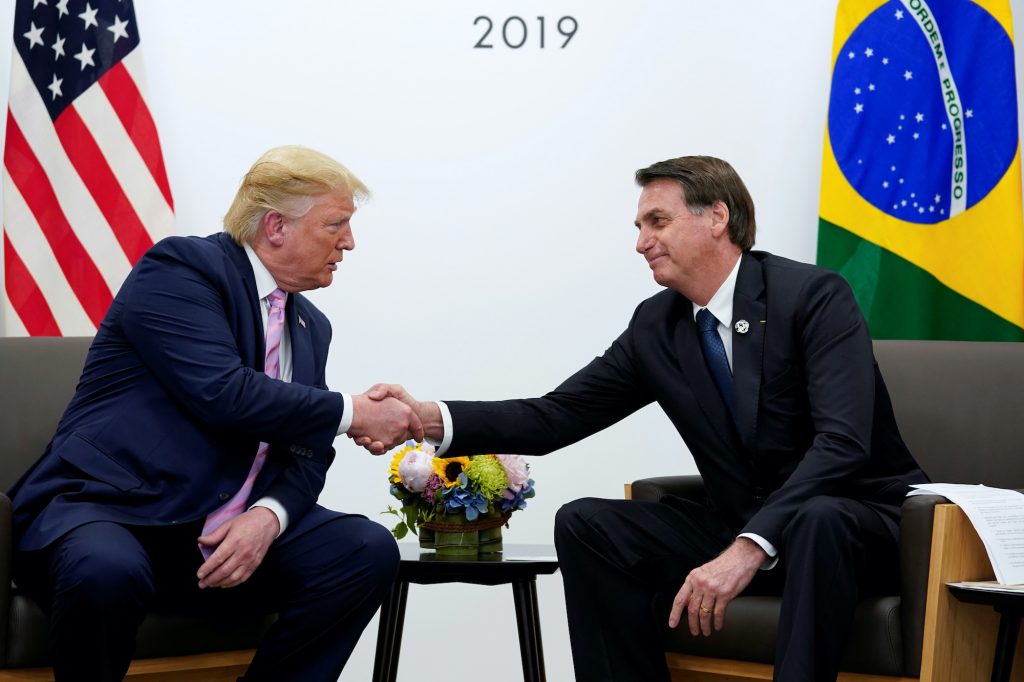
President Trump offered his support for Brazil’s accession to the OECD—a process that started in 2017 with Brazil formally expressing its interest in joining the organization—and President Bolsonaro announced that Brazil will begin to forgo special and differential treatment in World Trade Organization (WTO) negotiations.
Share this quoteBrazil and the United States have long made strides toward the potential negotiation of an FTA. This would be the most ambitious and wide-ranging economic and trade measure toward which both countries could aim. Estimates predict that a US-Brazil FTA would have a net positive impact not only on both countries’ gross domestic product (GDP) and national income, but also on exports, imports, wages, and employment. 15 Impact of a US-Brazil Trade Agreement. Brazil-US Business Council. Accessed at: https://www.us-chamber.com/sites/default/files/documents/files/ busbc_trade_agreement_initiative_report.pdf An FTA would also create a long-standing legal framework that would further integrate both economies, and would shape the trade and investment patterns between them in the future.
However potentially positive an FTA may be, it is a long-term goal. The production of mutually beneficial results will demand time, resources, and political capital. There are several stages in the process of negotiating an FTA. In the US case, there is the need to notify Congress prior to the start of trade talks. Special pre-initiation assessments and congressional consultations are required, including an assessment of existing tariff disparities on agricultural products and an assessment by the International Trade Commission of import-sensitive agricultural products.
On the Brazilian side, it is necessary to decide whether the agreement would be a joint enterprise alongside the Southern Common Market (Mercosur), or whether it would be a bilateral undertaking—which would entail changes to the current legal structure of Mercosur.
Once talks formally start, multiple rounds and strenuous hours of negotiations are needed to reach agreements on a vast array of technical issues, involving numerous negotiating teams, private-sector consultations, and political instructions. If a deal is reached, the United States and Brazil would run the “last mile” of legal revisions, signing, congressional approvals, and, finally, ratification.
In a nutshell, the road to an FTA is a long one. As such, various steps can be taken to ripen the path to an eventual agreement.
As a member of Mercosur, Brazil is bound by its rules to negotiate tariff agreements as part of the trading bloc. 16 Decision CMC 32/00, from the Common Market Council of Mercosur, states that tariff preferences to third parties from extra zone must be jointly negotiated.
Until recently, the administration of President Bolsonaro had firmly maintained its commitment to pursuing FTAs together with Mercosur, especially after successfully concluding negotiations in 2019 with the European Union and the European Free Trade Area (EFTA)—blocs that represent a combined gross domestic product (GDP) of $20 trillion.
But, the change in administration in Argentina, with Alberto Fernández assuming the presidency in December 2019, may impact next steps. Despite Brazil and Argentina’s long relationship as partners and allies, the two administrations may not see eye to eye on all issues of global integration. Such a position could eventually lead to new Mercosur legislation granting members full autonomy to negotiate treaties. It could also lead to a downgrade in Mercosur’s status from an “incomplete common market” to a “free trade area”—which would allow its members to unilaterally change their import tariffs. On the other hand, a pragmatic approach by the Argentine administration would open the door for continued cooperation through the existing Mercosur mechanism.
Any changes to the Mercosur normative framework require consensus from all Mercosur members, including Argentina. This is also valid for somewhat simpler modifications, as is the case of Decision CMC 32/00, which states that tariff preferences given to third parties must be jointly negotiated. A return to a free trade area involves even more complex and time-consuming legal and political arrangements.
Conversely, a withdrawal from Mercosur would be a last resort, with significant consequences. A withdrawal would impact Mercosur’s ongoing trade negotiations with third parties, as well as the recently concluded European Union-Mercosur trade agreement (as the agreement has not yet been signed and the European Union mandate was to negotiate with Mercosur as a bloc, and not with individual countries). It would also lead to time-consuming discussions regarding what tariffs would be in place in trade between Brazil and the other Mercosur countries.
All alternatives seem to come with a substantial cost to the political balance in the region, and would demand considerable time and energy.
Against this backdrop, from Brazil’s perspective, the case for an FTA negotiation with the United States is an incredible opportunity but not a simple task: FTA negotiations would have to take place within and alongside Mercosur (which demands Argentina’s new government be onboard and the United States be keen to negotiate with the four Mercosur countries as a trading bloc), or Brazil would come up against the need to adjust Mercosur’s rules to allow a bilateral negotiation.
Nevertheless, 2020 provides an opening to glance at alternative opportunities that could pave the way for an eventual FTA.
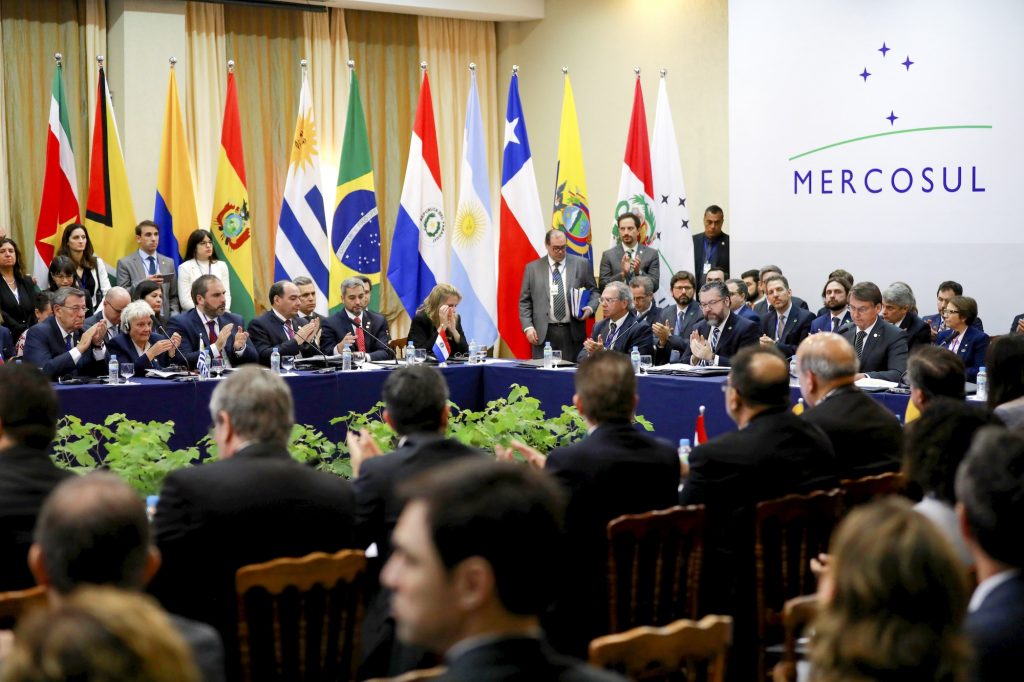
Brazilian President Jair Bolsonaro, Uruguayan Vice President Lucia Topolansky, Paraguayan President Mario Abdo Benitez, and Chilean Foreign Minister Teodoro Ribera attend a Mercosur summit, in Bento Gonçalves, Rio Grande do Sul, Brazil, December 5, 2019.
Share this quoteDuring President Bolsonaro’s visit to Washington in March 2019, Presidents Trump and Bolsonaro committed to “enhancing the work of the United States-Brazil Commission on Economic and Trade Relations, created under the Agreement on Trade and Economic Cooperation (ATEC) to explore new initiatives to facilitate trade investment and good regulatory practices.” 17 Joint Statement from President Donald J. Trump and President Jair Bolsonaro. The White House. March 19, 2019. Accessed at: https://www.whitehouse.gov/briefings-statements/joint-statement-president-donald-j-trump-president-jair-bolsonaro/
In a historic move, President Trump also welcomed Brazil’s ongoing efforts to institute much-needed domestic economic reforms, as well as a regulatory framework in line with the standards of the OECD.
From the US perspective, the moment is ripe for both countries to engage in productive conversations that will yield positive outcomes for both parties and the private sector. The personal relationship between both presidents and their directives to reevaluate their respective countries’ trade relations presents a unique opportunity for dialogue and concrete results.
While an FTA should continue to be the goal toward which the United States and Brazil strive, given administrative and legislative priorities, results in the short term are key to laying the groundwork for an eventual agreement. The building blocks for a potential FTA between Brazil and the United States will be the short-term opportunities, which—if successfully implemented over the current year—can pave the way for a potential FTA and for the various long-term recommendations laid out in this paper.
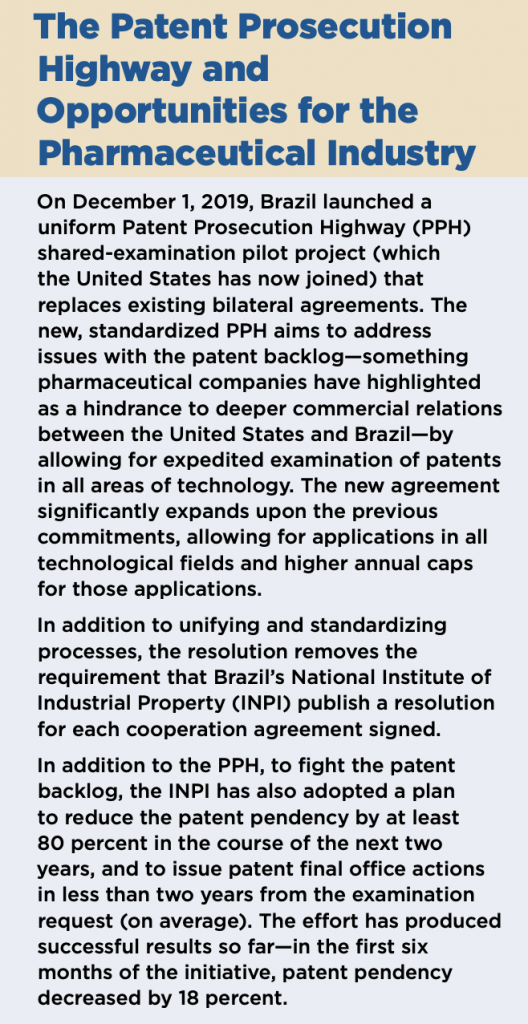
As the United States and Brazil work to deepen trade of goods, the United States will look to seize on opportunities to increase regulatory cooperation, identify and eliminate technical barriers, and identify new openings for harmonizing standards and assessment procedures.
Share this quoteA focus on goods
Though the United States and Brazil have made progress on trade and investment over the years, Brazil remains one of the countries with the highest tariff barriers. As the United States and Brazil work to deepen trade of goods, the United States will look to seize on opportunities to increase regulatory cooperation, identify and eliminate technical barriers, and identify new openings for harmonizing standards and assessment procedures.
Brazil’s Most Favored Nation (MFN) applied tariff averaged 10.2 percent for agricultural products and 13.9 percent for non-agricultural products in 2017. Brazil’s WTO maximum bound-tariff rates are 55 percent for agricultural products and 35 percent for non-agricultural products.
US exporters face significant uncertainty as result of frequent increases and decreases in tariffs. According to the World Bank, Brazil’s average (trade-weighted) tariff rate was 8.3 percent in 2015, the highest rate among emerging and advanced economies.
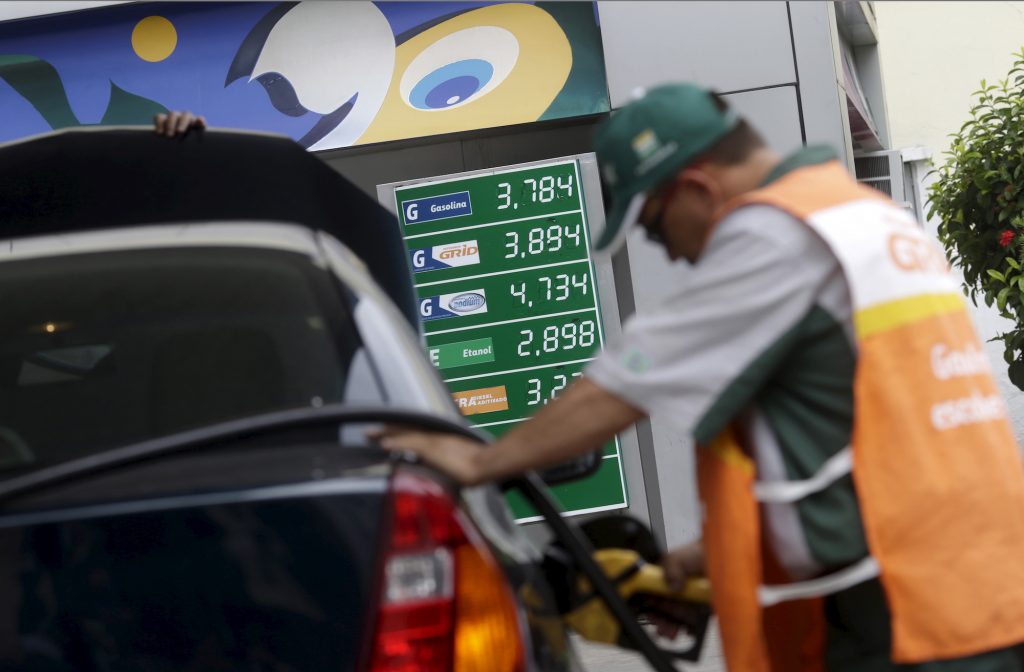
Though the United States and Brazil have made progress on trade and investment over the years, Brazil remains one of the countries with the highest tariff barriers.
Share this quoteAccording to the USTR, Brazil imposes relatively high tariffs on a variety of sectors, including automobiles, automotive parts, chemicals, plastics, information and communications technologies (ICT), industrial machinery, steel, textiles, and apparel. 18 Brazil. Office of the US Trade Representative. Accessed at: https://ustr.gov/sites/default/files/2013%20NTE%20Brazil%20Final.pdf
Beyond tariffs, US industrial goods are subject to non-tariff barriers to trade. These barriers include import licensing, product standards, conformity assessment procedures, and technical regulations. As an example, the United States and Brazil take different approaches to the recognition of international standards. Conformity-assessment procedures for toys and medical devices are examples of areas for discussion and improvement. 19 Ibid. The complexity of meeting unique country requirements is particularly burdensome on small and medium-sized enterprises (SMEs). Such non-tariff measures create additional costs and loss of time for businesses and consumers. According to estimates using data from the United Nations Conference on Trade and Development Trade Analysis Information System (UNCTAD TRAINS) and UN Comtrade data, the ad-valorem equivalent of non-tariff measures is almost 12 percent. 20 Reis, et al. Trade Liberalization and Integration of Domestic Output Markets in Brazil. Policy Research Working Paper 8600. World Bank. Page 6. Accessed at: http://documents.worldbank.org/curated/en/848981538569408470/pdf/WPS8600.pdf
Although some of these non-tariff measures serve legitimate health-and-safety policy objectives, a higher percentage of products are subject to such measures in Brazil than world averages. The percentage of imports subject to sanitary and phytosanitary measures and technical barriers, for example, is 66 percent and 89 percent, respectively, as compared to 26 percent and 61 percent, respectively, per the World Bank. 21 Ibid.
There are also opportunities to improve trade logistics and trade facilitation between the United States and Brazil. Brazil ratified the WTO Trade Facilitation Agreement in 2016 and continues to work toward implementation of the agreement.
US companies continue to express concerns regarding burdensome and inconsistent documentation requirements for imports of certain goods, (e.g., heavy equipment). While great progress has been made in certain sectors (e.g., medical devices), unpredictability and delays in customs clearance remain problematic in other sectors (e.g., pharmaceuticals).
Brazil has improved its trade-facilitation environment by implementing ATA Carnet, an international customs process permitting the duty-free and tax-free temporary export and import of goods for up to one year, per the International Chamber of Commerce. 22 ATA Carnet. International Chamber of Commerce. Accessed at: https://iccwbo.org/resources-for-business/ata-carnet/
The country has also done so by working toward a mutual recognition agreement with the United States for its Authorized Economic Operator program. The AEO is a partnership program that many customs administrations are pursuing to facilitate global trade by providing incentives to customs and traders that have decided to work in partnership to improve supply-chain security, per the World Customs Organization. 23 Mutual Recognition Arrangement/Agreement Strategy Guide. World Customs Organization. June 2018. Accessed at: http://www.wcoomd.org/-/media/wco/public/global/pdf/ topics/facilitation/instruments-and-tools/tools/safe-package/strategy-guide-for-aeo-mutual-recognition.pdf?la=en The mutual agreement refers to two countries closing an agreement or arrangement to mutually recognize AEO authorizations.
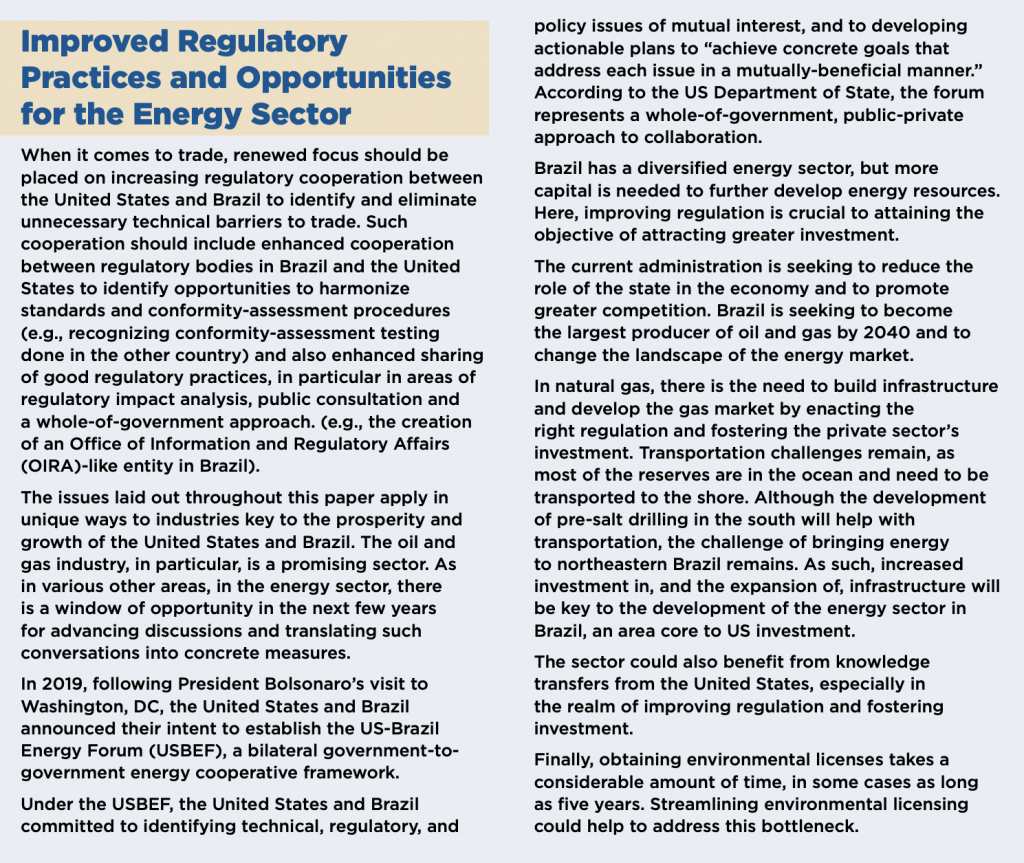
A focus on services
Brazil has more restrictions on trade in services than the average country in Latin America, according to the World Bank Services Trade Restrictiveness Index (STRI), with the most restrictive scores in financial and professional services, essential for productivity growth and competitiveness. 24 Reis, et al. Trade Liberalization and Integration of Domestic Output Markets in Brazil. Policy Research Working Paper 8600. World Bank. Page 7. Accessed at: http://documents.worldbank. org/curated/en/848981538569408470/pdf/WPS8600.pdf
US companies experience barriers to trade across a wide variety of services sectors. For example, services barriers in audiovisual services include: higher taxes on foreign film; requirements of percentages of programming by Brazilian on “open-broadcast” channels; express delivery (e.g., 60-percent duty on goods imported through Simplified Customs Clearance, lack of a de minimums exemption, partially funded automatic express-delivery clearance system, per-shipment value limits of $10,000 per exports, and $3,000 for imports); financial services (requirement that Brazilians be directly responsible for administration of a foreign bank subsidiary); and local content requirements (LCRs) in telecommunications. 25 Office of the US Trade Representative. Page 62-64.
Relevant gains for the United States
Given the size of Brazil’s economy and the successful implementations of US FTAs with other key countries in the region, it is clear that a US-Brazil FTA would bring tangible economic benefits to the United States.
First, an FTA would strengthen hemispheric commercial cooperation, enhancing the overall bilateral relationship between the United States and Brazil. As Brazil is by far South America’s largest economy, reducing barriers to trade would open this important market to US businesses. A 2016 study estimated an FTA would add $24 billion to US GDP and $30 billion to real national income, and expand employment by nearly one hundred thousand jobs. 26 National Confederation of Industry, American Chamber of Commerce for Brazil, and U.S. Chamber of Commerce. 2016. Accessed at: https://www.brazilcouncil.org/wp-content/uploads/2017/05/CNI_CEBEU_Roadmap_EUA-to-print.pdf Employment growth was projected in every US state.
The removal of tariffs would reduce the cost of imports from the United States to the Brazilian consumer, and would make US exports more competitive with US competitors in Brazil (e.g., China, the European Union, and other Mercosur countries). An FTA could also increase the predictability of US-Brazilian trade for US exporters. Per a 2018 National Trade Estimate Report on Foreign Trade Barriers by the Office of the United States Trade Representative, given the large disparities between bound and applied rates, US exporters face uncertainty in the Brazilian market. The unpredictability makes it difficult for exporters to forecast the costs of doing business. An FTA that would include the elimination or reduction of tariffs and non-tariff barriers would remove this fluctuation.
An agreement on good regulatory practices would support the development of compatible regulatory approaches in the United States and Brazil, and reduce or eliminate unnecessarily burdensome, duplicative, or divergent requirements. An agreement on good regulatory practices would also better enable effective regulatory cooperation. It would increase transparency in the regulatory process, providing a clear rationale for new regulatory actions, as well as encouraging cooperation on minimizing divergence in regulatory outcomes.
Furthermore, an FTA could streamline import licensing for US companies, removing entry barriers for US firms. Opportunities to streamline import-licensing processes via a potential FTA would help US businesses enter Brazilian markets faster and more inexpensively.
Finally, the strengthening of the US-Brazilian economic relationship through an FTA would likely have positive ramifications for the broader US-Brazilian relationships outside of the economy.
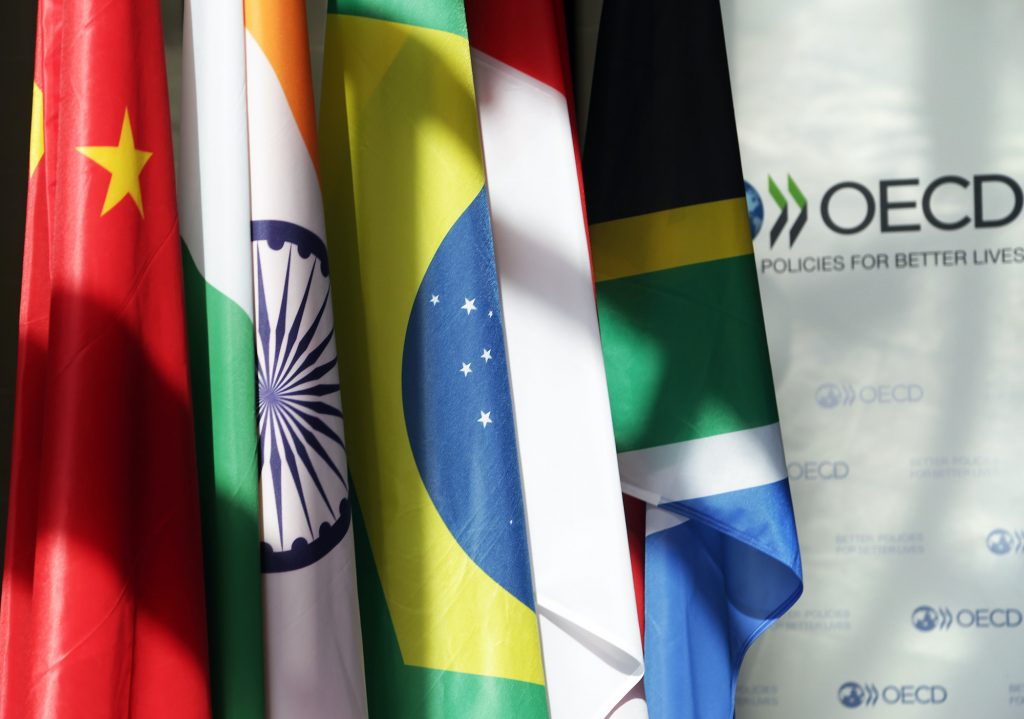
An agreement on good regulatory practices would support the development of compatible regulatory approaches in the United States and Brazil, and reduce or eliminate unnecessarily burdensome, duplicative, or divergent requirements.
Share this quoteIn recent years, Brazil has been walking more resolutely down the path of greater global trade integration. Negotiations between Mercosur and the European Union have changed gears with the exchange of market offers in May 2016, and gained real traction in 2017. In 2017, Mercosur formally engaged in negotiations with EFTA, and in 2018 launched FTA trade talks with Canada, Singapore, and South Korea.
Argentina under then-President Mauricio Macri and Brazil under then-President Michel Temer and President Bolsonaro initiated a phase of greater political and technical convergence when it came to trade negotiations, which allowed Mercosur to advance on the aforementioned initiatives. The modernization of Mercosur itself also got under way with the adoption of an investment agreement (2017), a public procurement agreement (2018), and revised rules for common technical regulations (2018).
On the bilateral level, Brazil signed its first-ever public procurement agreement in 2016 (Peru), ratified its first investment agreements with several countries in Latin America and Africa, and in 2018 signed a comprehensive FTA with Chile. The bilateral trade treaty with Chile, for the first time in Brazilian history, includes chapters on digital trade, trade and gender, trade facilitation, micro, small, and medium enterprises, the environment, and many others.
In 2017, Brazil formally expressed interest in becoming a member of the OECD, and became an observer to the WTO Government Procurement Agreement (GPA). At the multilateral level, Brazil has been one of the most active sponsors of discussions on investment facilitation and digital trade.
Under President Bolsonaro, the Brazilian transition toward a more ambitious trade policy gained extra momentum. The current Brazilian administration has defined trade integration as a top priority, having successfully concluded negotiations for the milestone trade deals with the European Union and EFTA (2019), and continued progress on formal talks with Canada, Singapore, and South Korea. The country has also begun dialogues with partners such as Japan, Lebanon, Indonesia, and Vietnam. Additionally, in 2020, Brazil expressed its intention to join, as a full member, the WTO GPA.
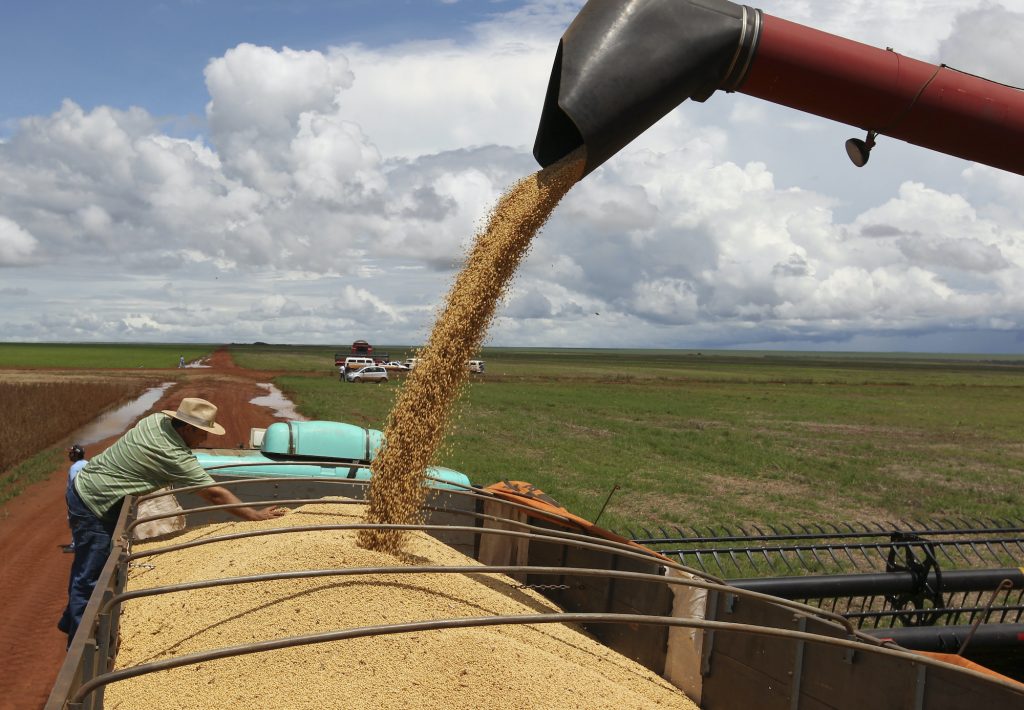
From the Brazilian perspective, the moment is ripe for laying the groundwork for an FTA discussion with the United States. It is seemingly a top priority for the Brazilian government, fitting perfectly into its current trade-negotiating directives. Taking into consideration the political convergence that exists between the heads of state from both countries, this is the ideal moment to begin paving the road to an FTA.
In his first year in office, President Bolsonaro tweeted at least five times his desire to initiate trade negotiations or address the relevance of stronger trade relations with the United States. 27 Tweets de Bolso. Aos Fatos. On trade negotiations (23 Aug 2019, 28 June 2019.). On trade relations (31 Aug 2019, 31 July 2019, 26 March 2019). Accessed at: https://aosfatos.org/tweets-de-bolso/ As 2020 elections in the United States approach, exploring more gradual and agile approaches, such as a multi-chapter trade enhancement agreement could produce relevant results and, at the same time, constitute an incremental step toward a future FTA.
In general, the Brazilian private sector also appears to support the idea that an FTA would generate gains for both sides, being perceived as a win-win initiative. Leading business entities in Brazil—such as the American Chamber of Commerce for Brazil (Amcham Brasil), the National Confederation of Industries (CNI), and the Federation of Industries of the State of São Paulo (FIESP)—have publicly supported an FTA with the United States.
A Focus on Goods
The United States has a low average tariff rate, particularly for industrial goods. According to the USTR, the average trade-weighted import tariff rate for non-agricultural goods is currently 2 percent, and half of those products are imported into the US market duty free. 28 Industrial Tariffs. Office of the US Trade Representative. Accessed at: https://ustr.gov/issue-eas/industry-manufacturing/industrial-tariffs
From an export perspective, one could say Brazil would not gain much when it comes to reducing tariff barriers on industrial products as a result of an FTA. However, this would be too narrow an analysis.
Several exceptions exist. Apparel and clothing accessories are one good example: average tariffs for knitted or crocheted clothing are 18.7 percent, and for non-knitted or crocheted items are 15.8 percent. Natural wool, yarn, and woven fabrics carry a 13.1-percent duty. Footwear is taxed at 11.8 percent. Import duties for jewelry, gemstones, and precious metals are 5.9 percent, and for furniture and bedding, 5.7 percent. 29 Desilver, D. US tariffs vary a lot, but the highest duties tend to be on imported clothing. Pew Research Center. Accessed at: https://www.pewresearch.org/ fact-tank/2018/03/28/u-s-tariffs-vary-a-lot-but-the-highest-duties-tend-to-be-on-imported-clothing/
The United States is also utilizing measures under Section 232 of the Trade Expansion Act of 1962, based on national security arguments, which lead to unilateral increase in duties or to quantitative restrictions on exports from Brazil.
In 2018, the United States imposed an additional 10-percent duty for Brazilian exports of aluminum, and slapped hard quotas on Brazilian exports of steel, limiting volumes using the average of years 2015–2017 as a reference. Under this same mechanism, there is an investigation under way regarding automobiles and automobile parts, which could affect Brazilian exports.
Tariffs aside, Brazilian industrial goods are subject to technical requirements for being marketed in the United States, which usually entails compliance costs associated with product and process adjustments, testing, and conformity assessment. Intensification of sectorial initiatives of regulatory cooperation and negotiation of rules for avoiding unnecessary technical barriers to trade (TBT) may, therefore, have substantial positive impacts for driving down costs and time in bilateral trade.
Market access for Brazilian agricultural goods in the United States also faces considerable constraints in the form of tariffs and quantitative restrictions. Although they represent only approximately 5 percent of Brazilian exports to the United States (2018), there is considerable potential for their expansion. 30 ComexVis: Paises Parceiros. Estados Unidos. Ministerio de Economia do Brasil. Accessed at: http://www. mdic.gov.br/comercio-exterior/estatisticas-de-comecio-exterior/comex-vis/frame-pais?pais=usa
The United States and Brazil are world leaders in producing and exporting agricultural products. They are fierce competitors in the global market, but may complement each other in certain areas, as is the case for ethanol, sugar, and meat. The two countries may also work together to access new international markets and develop common standards for agricultural goods.
Barriers to free trade in the agricultural sector are quite high in both countries. Trade restrictions exist for Brazilian exports of sugar, cotton, soy complex, tobacco, orange juice, and dairy—all which face tariff quotas or high tariffs to enter the United States. In many cases, tariffs imposed outside the quotas are de facto prohibitive. In other instances, Brazilian exports are de jure forbidden from the US market, usually due to certification or sanitary and phytosanitary (SPS) restrictions, as is the case for fresh beef, poultry, avocado, persimmon, fig, and starfruit, among others. 31 Desafios e Oportunidades a Exportacao de Produtos Brasileiros aos Estados Unidos. Brazilian Embassy in Washington. August 2018. Accessed at: https://sistemas.mre.gov.br/kitweb/datafiles/Washington/en-us/file/Desafios%20e%20Oportunidades%20à%20Exportação%20de%20Produtos%20Brasileiros%20aos%20EUA.pdf
Negotiations on agricultural products tend to be highly sensitive, as they involve deep-rooted political arrangements and special interests. One should expect nothing different if the United States and Brazil decide to engage on these topics as a part of FTA talks, incorporating discussions on building bilateral SPS rules, revisiting SPS restrictions, and eliminating or reducing import-tariff barriers.
Government procurement: A new horizon for Brazil
When it comes to public procurement, Brazil is a new player on the global scene. Brazil signed its first international agreement on public procurement only in 2016, with Peru. Since then, Brazil’s position has grown stronger—Brazil signed a deal within Mercosur in 2017 and with Chile in 2018. In 2019, Mercosur concluded negotiations on agreements with the European Union and the European Free Trade Association, both of which have chapters on public procurement, and the bloc is currently negotiating with Canada, Singapore, and South Korea. Although still not a member, Brazil became an observer to the WTO GPA in 2017, and in 2020 announced its intention to become a full member.
There is a predominantly positive view in Brazil about the aforementioned agreements, as they are seen as mechanisms to add more transparency in public procurement in the country and, above all, to enhance the quality of public spending, considering the Brazilian government faces growing and challenging budgetary restraints. It is unlikely, therefore, that public procurement would be an issue of much contention, at least from the Brazilian government side, if and when it gets to the negotiating table with the United States. This does not mean, however, there will be full endorsement from business sectors directly affected by such an agreement, as they may look to preserve the Brazilian market and for reciprocity within the US market.
On the other hand, some measures comprising the Buy American Act may be subject to special attention from the Brazilian negotiators, as they curtail the possibility of participation of Brazilian companies or demand high thresholds of local content in government procurement in the United States, including, for instance, in infrastructure, defense, and energy projects. The Brazilian government assesses that Brazilian business is potentially affected by US restricting measures in US purchases in the sectors of food, textile, and steel products. 32 Ibid.
A focus on services
The United States is Brazil’s main destination for the export of services. In 2017, the United States represented more than 50 percent of Brazilian foreign sales of services, totaling nearly $16 billion, according to Brazil’s trade statistics. In 2018, exports to the United States dropped to $8.7 billion. The most relevant services exported included technical services, water transportation, app designing, and financial services, among others.
In 2018, the United States was second only to the Netherlands as the country of origin for Brazilian imports of services. The total amount of services purchased from the United States by Brazil was $12.5 billion. Relevant sectors included licensing for producing rights, leasing of machinery and equipment, advertisement services, and licensing for the use of computer software.
It is important to note that, both in export and import flows, US official statistics differ significantly from Brazilian ones. As a reference, 2018 US data indicate US services exports to Brazil totaled $28.2 billion (more than twice the Brazilian data), and US services imports from Brazil reached $6.1 billion. 33 US Trade in Services by Selected Countries and Areas. US Census Bureau. Accessed at: https://www.census.gov/foreign-trade/Press-Release/current_press_release/exh20b.pdf As a consequence, the United States had a services trade surplus of an estimated $22 billion. Explanations to justify such substantial disparities and ensure common understanding regarding bilateral trade statistics must be further explored by both governments.
Irrespective of the differences in figures, the relevance of bilateral trade in services suggests that negotiating a services agreement between Brazil and the United States could generate substantial benefits for both countries. On the Brazilian side, sectors that would benefit from such an agreement could include financial services, legal and accounting services, managerial services, information-technology services, and marketing and recreational services, among others. 34 Plano Nacional de Exportações 2015-2018. Accessed at: http://www.mdic.gov.br/images/REPOSITORIO/ascom/PNCE/PNE_-_2015-2018.pdf
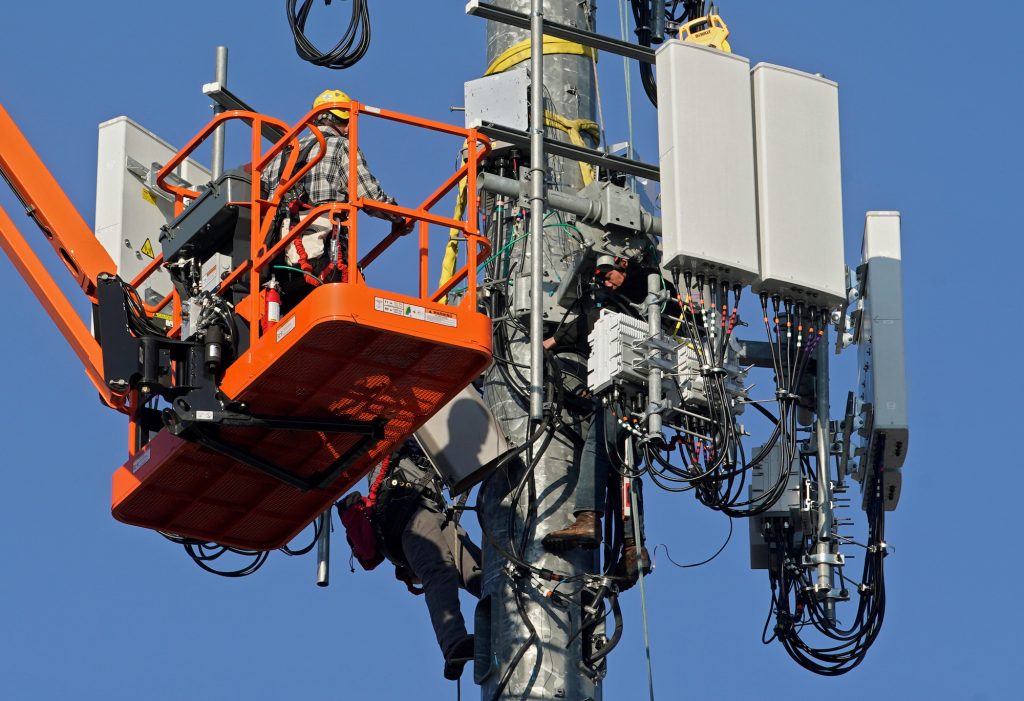
According to a done study by Amcham Brasil and Fundação Getulio Vargas, a free trade agreement would increase Brazil’s GDP by up to 1.3 percent (more than $38 billion) by 2030.